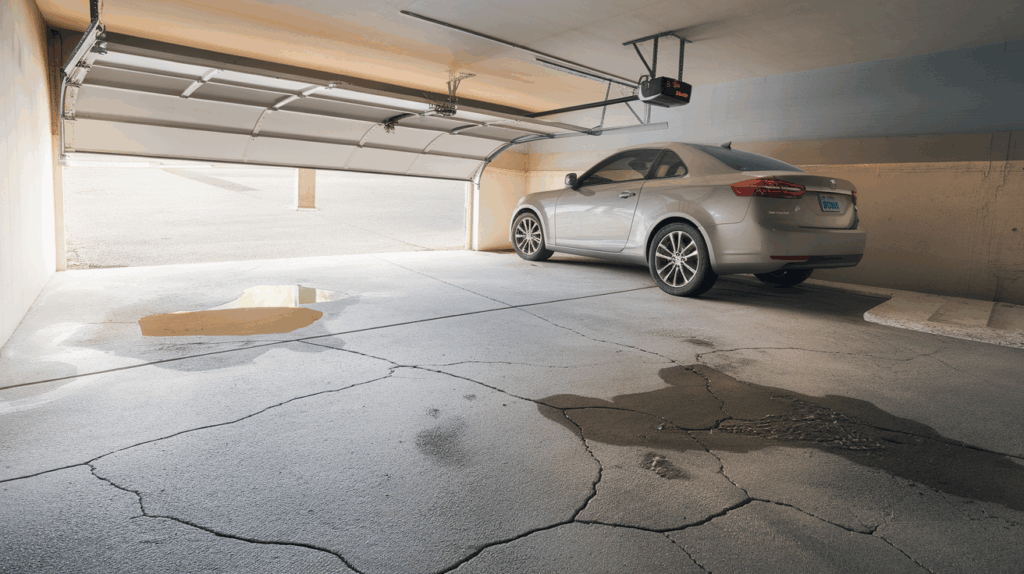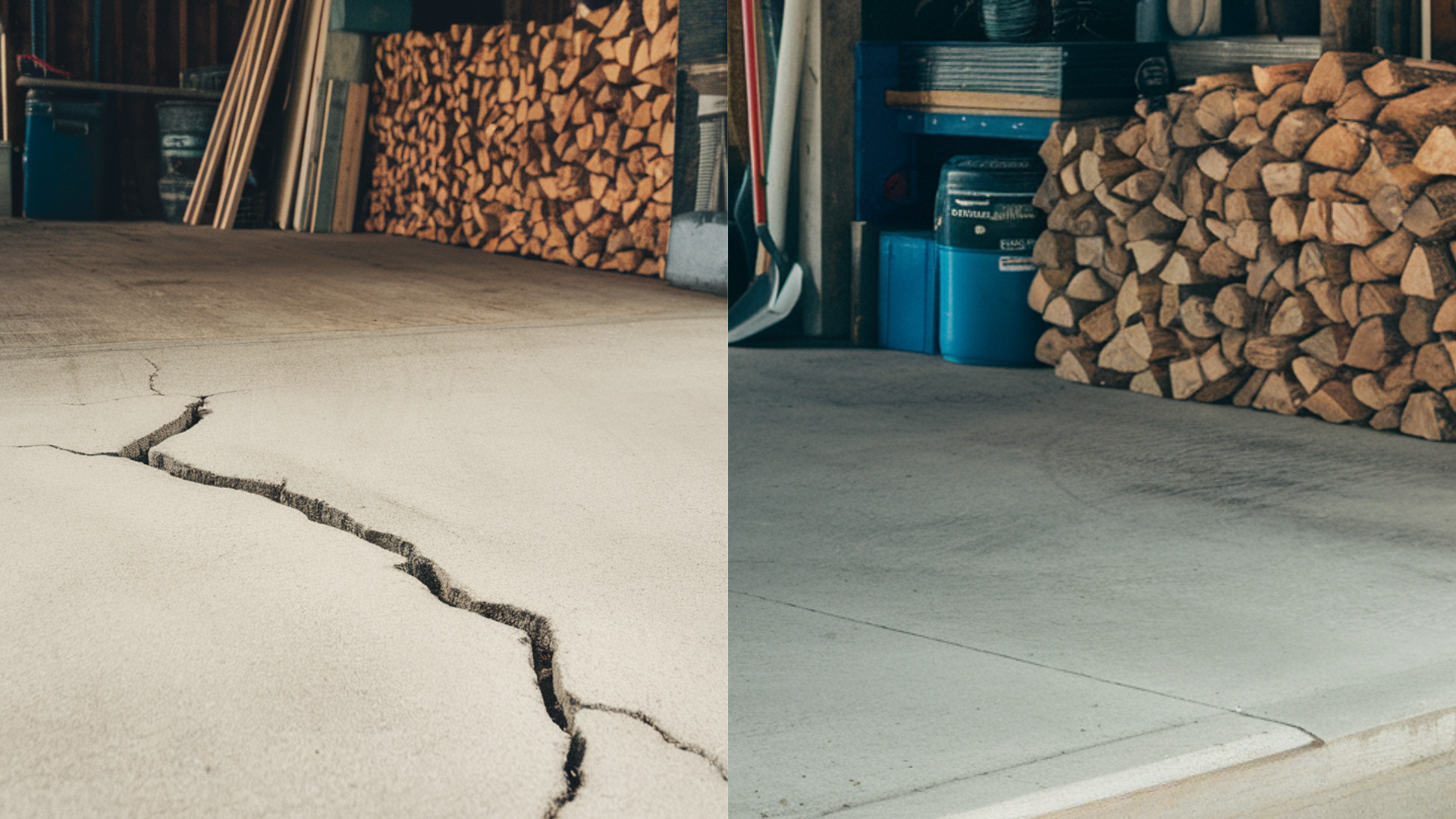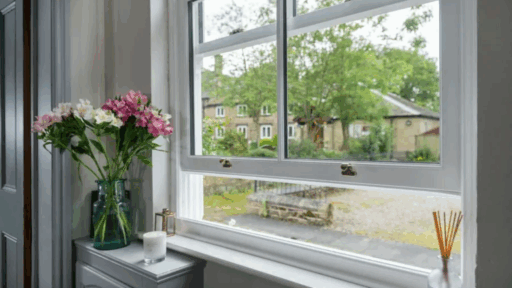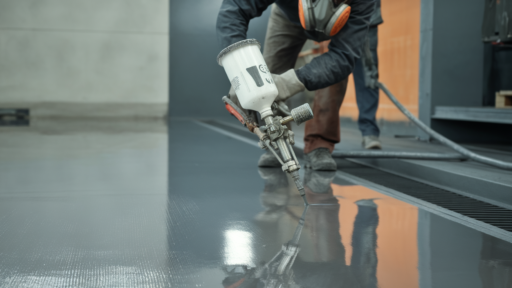Garage floors often get overlooked until cracks show up, the surface starts to slope, or water begins to pool in low spots. Maybe the car rocks a bit when parked, or tripping hazards appear where the floor once felt level.
A cracked, uneven garage floor isn’t just unattractive; it can lead to bigger problems, from safety risks to long-term structural damage. It might even lower your home’s value.
The good news? Most floors can be fixed without replacing the entire slab. I’ve dealt with this issue and learned that, whether the damage is minor or more serious, there are smart repair options available.
In this post, you’ll learn what causes garage floors to crack or sink, how to tell if it’s a big deal, and what steps to take. You’ll also find tips to help prevent future damage and maintain stability.
Signs Your Garage Floor Has a Problem

An uneven or cracked garage floor isn’t always easy to spot at first. Small signs can appear slowly, but they often indicate larger problems developing underneath.
1. Hairline Cracks: Hairline cracks are thin, shallow, and often caused by normal drying and settling. They usually don’t affect the floor’s structure and can be sealed easily.
2. Structural Cracks: Structural cracks, on the other hand, are typically wider (over 1/4 inch), deeper, and may extend across the entire floor. If the crack is growing or uneven on both sides, it’s likely a more serious issue.
3. Sloped or Sunken Areas: If the floor feels uneven underfoot or the car seems tilted when parked, sections of the slab may have settled. This usually happens when the soil beneath shifts or wasn’t compacted properly.
4. Water Pooling in Corners: Water collecting in certain areas even after light rain can be a sign of an uneven surface. Sloped floors cause drainage issues, and standing water can lead to concrete erosion, mold, or ice problems.
5. Difficulty Closing Garage Doors: When the floor shifts or sinks, the garage door may not close evenly or may leave gaps. You might also notice the door rubbing against the floor or frame. This is often due to alignment changes caused by an uneven slab.
6. Tripping Hazards on the Surface: If you or someone else has tripped on small ridges or raised edges, that’s a red flag. Cracks with height differences, crumbling corners, or broken sections can all become safety hazards.
What Causes Garage Floors to Crack and Shift
A garage floor might look solid, but it depends heavily on what’s happening underneath and around it. Cracks and uneven spots usually develop slowly and are often caused by natural forces or construction-related issues.
Soil Settlement Beneath the Slab
One of the most frequent causes of a sinking garage floor is soil movement. If the ground under the concrete wasn’t compacted well during construction, it may settle unevenly over time.
This creates empty spaces beneath the slab, which leads to cracks and sinking as the weight of the floor and vehicles above pulls it downward.
Poor Concrete Mix or Curing
Concrete needs the right balance of water, cement, and aggregates to be strong. If the mix is too weak or wasn’t allowed to cure properly, the slab may become brittle and prone to cracking.
Rapid drying, cold weather, or poor workmanship during installation can all weaken the final result.
Moisture Infiltration and Erosion
Water seeping through cracks, walls, or from under the slab can erode the soil and compromise the foundation. Over time, this causes the concrete to shift or sink.
Moisture can also weaken the concrete itself, especially if it contains salts or chemicals that speed up deterioration.
Heavy Loads Over Time
Garage floors are built to hold weight, but not always indefinitely. Parking heavy trucks, storing large appliances, or placing industrial equipment in the same spot for years can create stress points.
These concentrated loads can cause the slab to crack or dip under pressure.
Freeze-Thaw Weather Cycle
In colder regions, freezing and thawing cycles can cause significant damage to concrete. Water seeps into tiny pores and cracks, freezes, expands, and then thaws repeatedly.
This constant expansion and contraction weakens the structure and eventually leads to visible cracks and surface crumbling.
How to Fix Uneven and Cracked Garage Floors
Fixing an uneven and cracked garage floor starts with identifying the type and extent of damage.
For small cracks, a concrete patch or crack filler works well and can be applied with basic tools after the area is cleaned.
Shallow low spots or surface unevenness can often be leveled using a self-leveling compound, which spreads smoothly across the floor.
For deeper sinking or wide cracks, professional repair methods such as slabjacking or polyurethane foam injection may be necessary to lift and support the slab from underneath. Sealing the floor after repair helps protect it from future damage.
With the right materials and approach, most garage floors can be restored to a safe and even condition without full replacement.
How Much Do Garage Floor Repairs Typically Cost

When I noticed my garage floor starting to crack and dip, I knew I had to understand what the repair might cost. I put together this table to help make sense of the different price ranges based on what you might need.
| Repair Type | Estimated Cost Range | Details |
|---|---|---|
| DIY Crack Filling or Patching | $50 – $200 | Includes materials like patch kits, epoxy, or self-leveling concrete. |
| Basic Professional Repairs | $300 – $800 | Contractor services for crack filling and surface patching. |
| Slabjacking or Foam Injection | $1,000 – $3,000 | Lifts uneven slabs using grout or foam; less invasive than full replacement. |
| Full Concrete Slab Replacement | $4,000 – $6,000+ | Complete removal and replacement of the garage floor slab. |
| Long-Term Maintenance (e.g., sealing) | $100 – $300 (every few years) | Helps prevent new cracks and surface damage. |
I’ve learned it’s important to assess the damage carefully before jumping into repairs. Getting multiple estimates from licensed concrete professionals can help avoid surprises and save money in the long run.
I also recommend keeping up with maintenance – something as simple as sealing the floor every few years can go a long way.
When It’s Time to Call a Pro
Knowing when to call a professional can save time, money, and stress. If your garage floor has wide, deep, or growing cracks, it could be more than a surface issue.
Structural shifting or foundation movement often requires expert evaluation to prevent further damage.
Water seeping through cracks or mold developing in damp corners is another indication that the problem extends beyond its apparent surface.
Repeated DIY repairs that don’t hold up typically indicate an underlying issue that requires proper diagnosis and treatment.
If you’re considering selling your home, a cracked or uneven garage floor can detract from its appeal and value.
A professional can assess the situation and recommend lasting solutions that protect your investment and ensure safety.
Garage Floor Damage Prevention Tips
Preventing damage to your garage floor is often easier and more affordable than fixing it later. By taking a few smart precautions, you can avoid cracks, sinking, moisture problems, and surface wear before they start.
- Ensure proper drainage: Water pooling near the garage can erode soil and cause the slab to shift. Use gutters and grading to direct water away.
- Avoid long-term heavy loads: Don’t leave heavy equipment or vehicles in one place for months. Rotate or reposition to reduce floor stress.
- Control indoor moisture: A dehumidifier or proper ventilation helps prevent damp conditions that weaken concrete and promote mold growth.
- Skip deicing salts: Salt can break down concrete over time. Use sand or a garage-safe alternative in winter to avoid damage.
- Fix small cracks early: Sealing minor cracks right away prevents them from spreading and leading to more costly structural repairs.
Garage Maintenance Tips for Long-Lasting Floors
Regular maintenance is crucial for maintaining your garage floor in good condition. Even a strong concrete surface can wear down over time if dirt, moisture, and minor damage are left unchecked.
- Sweep regularly: Keeps dust, grit, and debris from wearing down the concrete surface over time. A clean floor also makes cracks and damage easier to spot.
- Inspect for cracks: Check the floor monthly for new or expanding cracks. Early detection means easier and cheaper repairs.
- Reseal every 1–2 years: A good concrete sealant protects against moisture, stains, and wear, extending the life of the floor.
- Clean spills quickly: Oil, gas, and chemical spills can soak in and damage concrete. Wipe them up right away to avoid stains and surface breakdown.
- Use protective mats: Place mats or pads under vehicles and heavy tools to prevent pressure points and surface scratching.
Conclusion
A cracked or uneven garage floor isn’t just a cosmetic issue it can lead to bigger problems if left untreated.
Whether the cause is shifting soil, moisture, or heavy loads, catching the signs early and choosing the right repair method can save you time and money.
From DIY fixes for minor cracks to professional solutions for serious damage, there’s always a path forward.
I suggest regular maintenance, sealing, and moisture control to help prevent future issues and protect your investment.
Not sure where to start? Don’t wait for the damage to get worse; get a professional assessment or take care of those small cracks today.
Your garage floor supports more than just your car – it supports your peace of mind.








